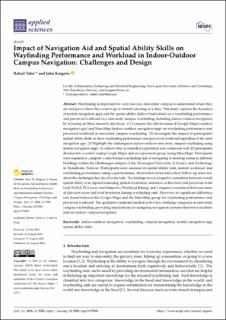| dc.description.abstract | Wayfinding is important for everyone on a university campus to understand where they are and get to where they want to go to attend a meeting or a class. This study explores the dynamics of mobile navigation apps and the spatial ability skills of individuals on a wayfinding performance and perceived workload on a university campus wayfinding, including indoor-outdoor navigation, by focusing on three research objectives. (1) Compare the effectiveness of Google Maps (outdoor navigation app) and MazeMap (indoor-outdoor navigation app) on wayfinding performance and perceived workload in university campus wayfinding. (2) Investigate the impact of participants’ spatial ability skills on their wayfinding performance and perceived workload regardless of the used navigation app. (3) Highlight the challenges in indoor-outdoor university campus wayfinding using mobile navigation apps. To achieve this, a controlled experiment was conducted with 22 participants divided into a control (using Google Maps) and an experiment group (using MazeMap). Participants were required to complete a time-bound wayfinding task of navigating to meeting rooms in different buildings within the Gløshaugen campus of the Norwegian University of Science and Technology in Trondheim, Norway. Participants were assessed on spatial ability tests, mental workload, and wayfinding performance using a questionnaire, observation notes and a short follow-up interview about the challenges they faced in the task. The findings reveal a negative correlation between overall spatial ability score (spatial reasoning, spatial orientation, and sense of direction) and perceived workload (NASA TLX score and Subjective Workload Rating) and a negative correlation between sense of direction score and total hesitation during wayfinding task. However, no significant difference was found between the Google Maps and the MazeMap group for wayfinding performance and perceived workload. The qualitative analysis resulted in five key challenge categories in university campus wayfinding, providing implications for designing navigation systems that better facilitate indoor-outdoor campus navigation. | en_US |

